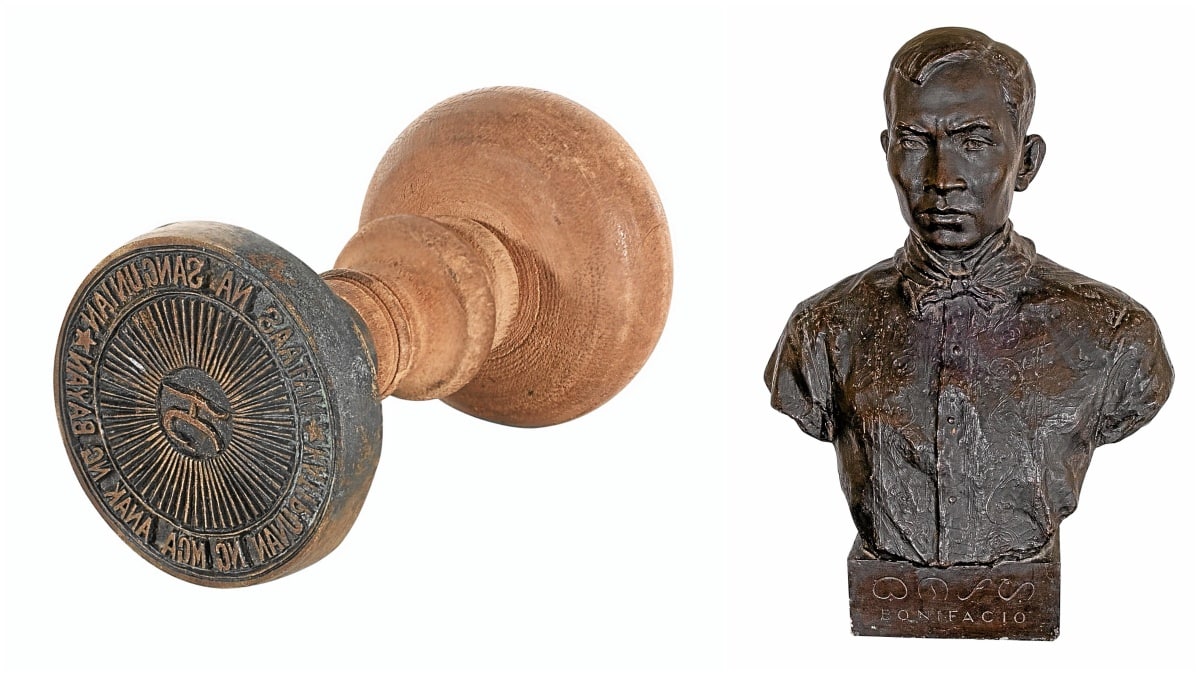Last Katipunan seal, Bonifacio bust up for auction today

REVOLUTIONARY The Katipunan seal (above) is said to be the “twin” to the one used by Katipunan leader Andres Bonifacio. Also up for bidding is a bust sculpture of the Supremo by National Artist Guillermo Tolentino (right). —PHOTOS FROM LEÓN GALLERY
The last surviving Katipunan seal and an Andres Bonifacio bust sculpted by National Artist Guillermo Tolentino will be auctioned today, Bonifacio Day, at the León Gallery in Makati City.
“It will be the perfect way to remember one of the Philippines’ greatest heroes, by time-traveling through these pieces,” León Gallery founder and owner Jaime Ponce de Leon told the Inquirer through online messaging.
“Bonifacio’s vision and sacrifices are both a reminder of our noble past and an inspiration to uphold his enduring legacy as the Father of the Philippine Revolution.”
Bonifacio, born on this day in 1863 in Tondo district, Manila, cofounded in 1892 the nationalist secret society Kataastaasan, Kagalanggalang na Katipunan ng mga Anak ng Bayan, commonly known as Katipunan.
He was its “presidente supremo” (supreme president) when the movement was discovered by the Spanish government in 1896, igniting what would be considered the first anticolonial revolution in Asia.
Article continues after this advertisement‘Twin’ seal
The Katipunan had seals as graphic symbols of its libertarian aspirations, as explained by art curator and writer Lisa Guerrero Nakpil in her text, “The Last Seal of the Katipunan: Only Surviving Twin of Bonifacio’s Seal Discovered,” written for León Gallery’s The Kingly Treasures Auction catalog.
Article continues after this advertisementThe seal up for auction is estimated to have been made in 1897, or about a year after Bonifacio established the Mataas na Sangunian (High Council) that served as the Katipunan’s governing body for Morong, Manila, Bulacan, and Nueva Ecija.
It has an engraving of the words “Mataas na Sangunian Katipunan ng Mga Anak ng Bayan” (High Council Society of the Sons of the Country), with a five-pointed star bookending each phrase.
At the center of the seal is an image of the sun with multiple rays that, as pointed out in the auction catalog, symbolizes the light to the path of freedom, and under which “a free country would flourish.”
The sun’s core has an inscription of the ancient Tagalog symbol for “Ka,” which may refer to the Katipunan itself as the instrument of liberation. It can also stand for the “utopian ideals of ‘Kalayaan’ (Liberty) and ‘Kapayapaan’” (Peace), writes Guerrero Nakpil in the auction catalog.
The catalog also describes the seal as a “twin” to the one believed to have been personally used by Bonifacio in issuing official documents and articles. The other seal was among the hero’s possessions lost to history with his tragic death on May 10, 1897.
Fortunately for the “twin,” it was kept by Julio Nakpil, a musician and composer who was part of another nationalist group, La Liga Filipina. He then joined the Katipunan and got appointed to the Mataas na Sangunian, first as “Mataas na Kalihim” (High Secretary) and later as “Mataas na Pangulo” (High President).
Nakpil eventually handed over the Katipunan seal as a gift to historian Trinidad H. Pardo de Tavera, who passed down the historical item to its present-day owners before the object found its way to the auction house.
The Katipunan seal has a total height of 3 inches (7.5 centimeters), with a round metal seal .75 cm in thickness connected to a wooden handle of turned wood with a knob at the end. Bidding starts at P1.6 million.
Tolentino sculpture
On the other hand, Tolentino’s Andres Bonifacio bust sculpture that is also up for auction comes from the private collection of historian and professor Ambeth R. Ocampo. He had acquired it from the late master sculptor’s widow, Paz Raymundo.
The artwork is one of several plaster casts from Tolentino’s “Bonifacio Monument” sculpture. The national artist was said to have based Bonifacio’s likeness on the hero’s younger sister, Espiridiona Bonifacio, and on the only photograph of the Father of the Philippine Revolution. Bidding starts at P400,000.
Another highlight of the León Gallery’s The Kingly Treasures Auction is an artwork made by Bonifacio’s inspiration, Jose Rizal.
“Josephine Sleeping” is a plaster of Paris figure of Rizal’s wife, Josephine Bracken, that the national hero created while he was in exile in Dapitan between 1895 and June 1896. It is believed to be his last artwork. Bidding starts at P7 million.
Auction starts at 2 p.m. at Eurovilla 1, Rufino corner Legazpi Streets, Legazpi Village, Makati City. INQ